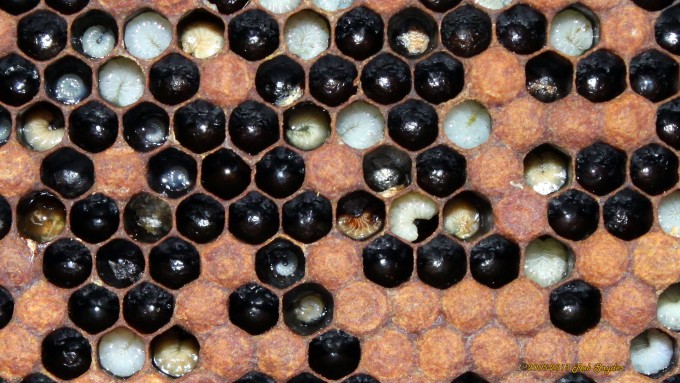European Foulbrood
Melissococcus plutonius
Useful Resources:
Description
While not as detrimental as American Foulbrood (AFB), European Foulbrood (EFB) is a disease that has the potential to decimate a honey bee colony under certain conditions. Like American Foulbrood, EFB targets and kills young larvae before they reach adulthood. Unlike American Foulbrood, however, EFB does not create spores, making this disease more manageable for both bees and beekeepers.
Etiology
The causative agent of European Foulbrood is Melissococcus plutonius, a non-spore-forming bacterium. EFB is seasonal in nature, occurring most often in early spring. Like American Foulbrood, this disease affects young larvae, less than 48 hours old. Nurse bees feed young larvae infected brood food. The ingested bacteria then begin to multiply in the midgut and compete with the larvae for food which causes infected larvae to request a greater than average amount of brood food. Those larvae are often removed from the colony by nurse bees if there is a large enough population. This hygienic behavior allows most colonies to contain an infection or rid the colony of it completely. If larvae aren’t ejected from the colony, they will eventually die in the cell, typically at the coiled stage before pupation.

EFB infected larvae (beeinformed.org)
Larvae will look twisted and dull and turn from pearly white to yellow to brown. Eventually, the larvae will completely desiccate and form a rubbery scale that can easily be removed. Like AFB, there is a shotgun appearance to the brood pattern. EFB also has a distinct sour odor of decay from which the disease gets the name “foulbrood”.
Spread and Control
Like AFB, European Foulbrood is spread from infected colonies to healthy ones via robbing and drifting bees. When a diseased colony inevitably dies, robbers from surrounding colonies rob the boxes of their EFB tainted honey and nectar, transmitting the bacteria to healthy hives. Beekeepers are also vectors of this disease. Care should be taken when interchanging frames between colonies, ensuring that no EFB is present. The same care should be taken when feeding honey or pollen. If a hive is suspected to have EFB, any equipment (hive tool, smoker, bee suit, etc.) should be sterilized immediately before manipulating other honey bee colonies.
European Foulbrood is associated with nectar dearths, high Varroa mite populations, and other colony stresses. Typically, colonies can rid themselves of this disease during a steady nectar flow. If, however the colony seems to be unable to stop the spread of disease, antibiotics may be used or colonies can be requeened. Requeening can add more hygienic behaviors to the colony and creates a break in the brood cycle allowing nurse bees to remove dead larvae and polish the cells.

